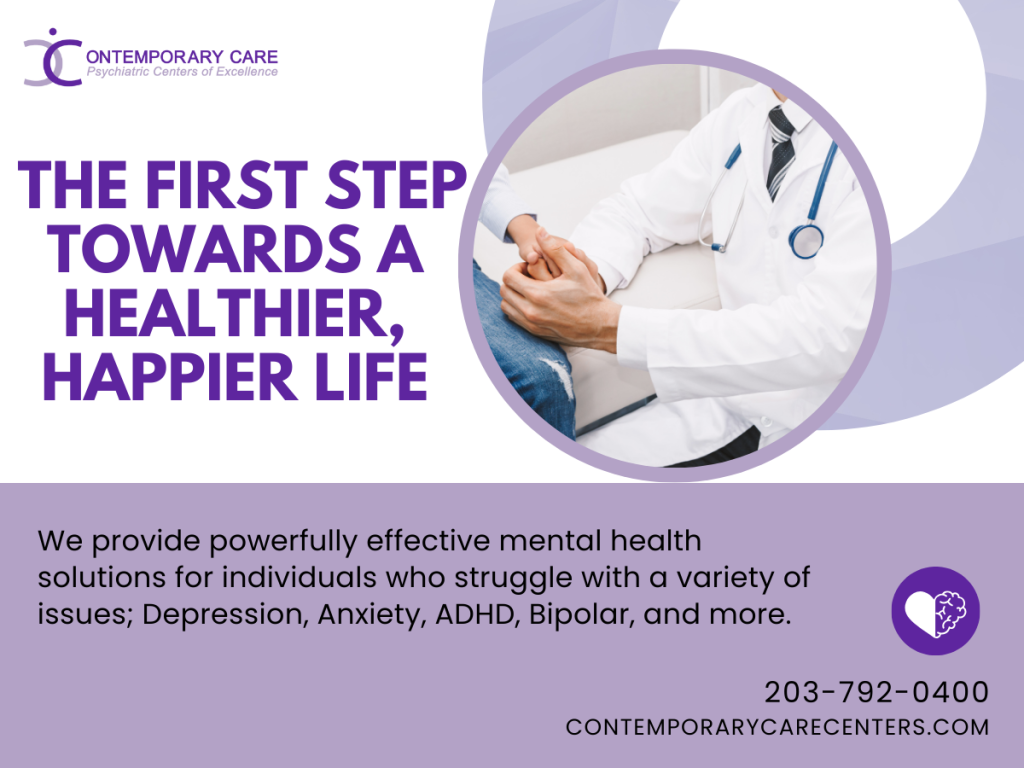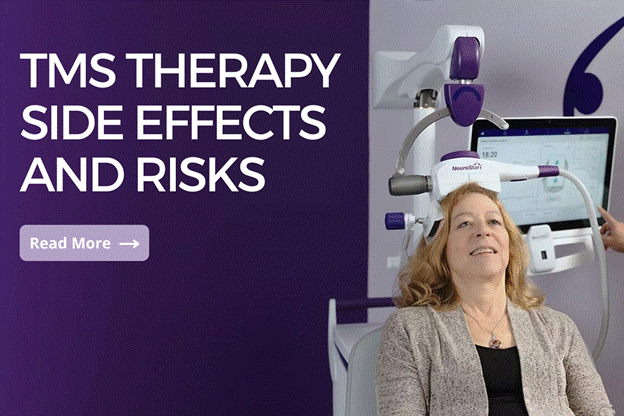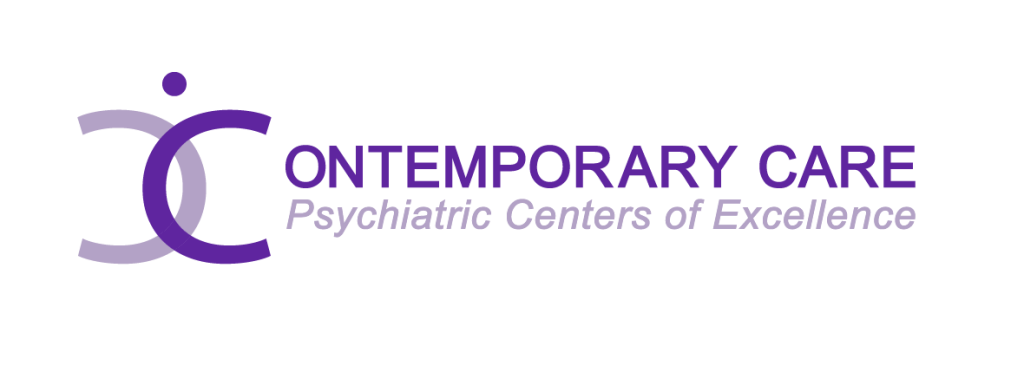Deep Transcranial Magnetic Stimulation (TMS) has emerged as a promising treatment option for various mental health disorders like major depression. But like any medical intervention, it may come with side effects. Understanding these potential side effects and knowing how to address them is crucial for patients undergoing TMS therapy CT.
In this comprehensive guide, we’ll dig into the common side effects of TMS and explore effective strategies for managing them.
Understanding Transcranial Magnetic Stimulation (TMS)
Before discussing the side effects of TMS, let’s briefly understand what this innovative therapy requires. TMS therapy is a non-invasive procedure that utilizes magnetic fields to stimulate nerve cells in the brain. It treats depression, anxiety, and many other mental health conditions and disorders when traditional treatments like medication and therapy haven’t been effective.
TMS has shown potential for anxiety disorders, including panic disorder and obsessive-compulsive disorder (OCD). The most targeted areas for OCD appear to be the orbitofrontal cortex and the supplementary motor area. Older protocols that targeted the prefrontal dorsal cortex were less successful. It has also been studied with autism, substance abuse, addiction, and post-traumatic stress disorder (PTSD).
For treatment-resistant major depressive disorder, high-frequency rTMS appears effective. Research on the efficacy of rTMS in non-treatment-resistant depression is limited.
Imagine your brain is like a big control center, right? Sometimes, certain parts of that control center need a little extra boost to work properly, especially parts involved with mood and emotions. That’s where TMS therapy comes in. It’s like giving those areas a gentle push to help them do their job better.
Repetitive Transcranial Magnetic Stimulation (rTMS)
Repetitive transcranial magnetic stimulation (rTMS) is a non-invasive brain stimulation technique involving the application of magnetic pulses to specific brain areas. Unlike single-pulse TMS, which delivers isolated magnetic pulses, rTMS administers multiple pulses over a defined period.
This repetitive TMS stimulation can modulate neuronal activity in targeted brain regions, leading to lasting changes in brain function. rTMS treats various neurological and psychiatric disorders, including depression symptoms, anxiety, and chronic pain. Its ability to modulate neural circuits and promote neuroplasticity makes it a promising therapeutic tool for improving brain function and treating various medical conditions.
How TMS Works?
Electromagnetic Coil Placement:
- The electromagnetic coil used in TMS is precisely positioned against the scalp, ensuring optimal contact with the targeted brain regions.
- The placement of the coil is determined based on the specific mental health or medical condition and the desired therapeutic outcome.
Delivery of Magnetic Pulses:
- Once the magnetic coil is in place, it delivers controlled magnetic pulses to the predetermined areas of the brain.
- These pulses are generated by passing a magnetic pulse or an electrical current through the coil, creating a rapidly changing magnetic field.
Stimulation of Nerve Cells:
- The magnetic pulses penetrate the scalp and skull, reaching the underlying brain tissue without causing any damage to the brain activity.
- As the pulses reach the targeted brain regions, they induce electrical currents within the nerve cells, activating them and facilitating communication between neurons.
Neurotransmitter Release:
- The stimulation of nerve cells by TMS triggers the release of various neurotransmitters from brain cells, including serotonin and dopamine.
- Serotonin and dopamine are neurotransmitters known for regulating mood, emotions, and cognitive functions.
Personalized Treatment Factors:
- TMS therapy is highly individualized, with treatment factors tailored to each patient’s unique neurobiology and clinical presentation.
- The intensity, frequency, and duration of therapy sessions are adjusted based on the patient’s response to treatment and any observed side effects.
Non-Invasive Nature:
- TMS is a non-invasive treatment option that does not require surgery or anesthesia.
- Patients remain awake and alert throughout the entire treatment.
Potential for Adjunctive Therapy:
- TMS can be used as a standalone treatment for a mental health illness or as an adjunctive therapy alongside medications and psychotherapy.
- Its versatility allows for integration into comprehensive treatment plans tailored to each patient’s needs.
Research and Advancements:
- Ongoing research in the field of TMS continues to explore new techniques and applications.
- Advancements in technology and methodology aim to improve the efficacy, safety, and accessibility of TMS therapy for patients worldwide.
Common Side Effects of TMS
While TMS is generally considered safe, some patients may experience side effects during or after treatment. It’s essential to note that not everyone will experience these side effects of TMS, and their severity can vary from person to person. Here are some common side effects of TMS:
Headache
One of the most reported side effects is a mild to moderate headache, typically occurring during or immediately after the session. This headache is usually short-lived and is managed with over-the-counter pain relievers like ibuprofen or acetaminophen.
Scalp Discomfort
During the procedure, some patients may experience mild discomfort or tingling sensations in the scalp area. This scalp discomfort is temporary and typically subsides once the session is complete.
Muscle Twitching
Patients might also experience twitching or tingling in their facial muscles. This twitching is a normal TMS therapy side effect and is not usually cause for concern. However, if it becomes bothersome, the technician can adjust the intensity of the magnetic pulses.
Lightheadedness
Some patients may feel lightheaded or dizzy immediately following a TMS session. This sensation is transient and often resolves within a few minutes. Patients are advised to sit or lie down until the dizziness passes and avoid standing up too quickly.
Hearing Changes
Since TMS produces loud clicking sounds during the procedure, patients may experience temporary changes in hearing sensitivity. These changes typically resolve once the session ends and are not considered a serious side effect.
Treating TMS Therapy Side Effects
While most side effects of TMS are mild and temporary, it’s essential to address any discomfort or concerns that patients may have. Here are some strategies for managing TMS side effects effectively:
Communication with the Health Care Providers
Open and honest communication with the TMS treatment provider is crucial for addressing any TMS therapy side effects or concerns. Patients should feel comfortable discussing their symptoms and asking about their treatment plan.
Proper Preparation and Relaxation Techniques
Engaging in relaxation techniques before and during TMS sessions can help alleviate anxiety and minimize the risk of experiencing side effects of TMS like headaches or lightheadedness. Deep breathing exercises, meditation, or listening to calming music can promote a sense of relaxation.
Hydration and Nutrition
Staying hydrated and maintaining a balanced diet can support overall well-being and help mitigate TMS therapy side effects like headaches or fatigue. Patients should drink enough water and consume nutritious meals to support their recovery.
Adjusting Treatment Parameters
If a patient experiences significant discomfort or TMS therapy side effects, the treatment provider can adjust the intensity or frequency of the magnetic pulses to optimize comfort and effectiveness.
Rare Risks of TMS treatment
While TMS is generally safe, it’s crucial to acknowledge rare or less frequent risks like seizures, mania, and hearing loss.
Remember to communicate openly with your doctor and TMS technician.
Seizures
Among the most concerning adverse effects of TMS are seizures. The risk of having a seizure from a TMS session is 0.01% or less than 1 in 10,000. While seizures are rare, occurring in less than 1% of patients, they represent a serious complication that requires immediate medical attention. Patients with a history of epilepsy or seizure disorders are at higher risk, and careful consideration is needed when recommending TMS therapy to such individuals.
Mania or Hypomania
In some cases, TMS for treatment-resistant depression may induce manic or hypomanic episodes, particularly in patients with bipolar disorder or a predisposition to mood fluctuations. These episodes are elevated mood, increased energy, less mood control, and impulsivity. Patients should be monitored closely for changes in mood or behavior during and after TMS therapy.
Hearing Changes
During TMS treatment, some patients may experience temporary changes in hearing sensitivity due to the loud clicking sounds produced by the magnetic pulses. This change typically resolves once the session ends and is not considered a serious side effect.
Neurological Symptoms
Rarely, patients undergoing TMS therapy may experience neurological symptoms such as dizziness, numbness, or tingling sensations in the extremities. These symptoms may occur during or shortly after the treatment session and typically resolve without intervention.
Managing Risks
Here are some strategies for managing the rare side effects of TMS:
Risk Assessment and Patient Selection
Before initiating TMS therapy, healthcare providers assess the patient’s medical history, including any risk factors. Patients with a history of seizures, bipolar disorder, or neurological conditions may require closer monitoring or alternative treatment options.
Watchful Monitoring During Treatment
During TMS sessions, healthcare providers closely monitor patients for any signs of adverse reactions to treatment, including changes in mood, behavior, or neurological symptoms. Prompt recognition and intervention can help mitigate the severity of TMS therapy side effects and ensure patient safety.
Individualized Treatment Plans
Tailoring TMS treatment plans to each patient’s unique needs and risk profile can help minimize the likelihood of adverse reactions. Adjustments to the treatment plan or parameters, such as the intensity or frequency of magnetic pulses, may be necessary to optimize safety and efficacy.
Patient Education and Support
Educating patients about the potential benefits and side effects of TMS therapy is essential for informed decision-making. Patients should be encouraged to report any unusual symptoms or concerns to their healthcare provider. Providing ongoing support and reassurance can help with depression treatments, alleviate anxiety symptoms, and promote treatment adherence.
TMS Side Effects vs Benefits
Benefits
- 60–65% Success/Efficacy Rate
- Non-invasive
- Potentially long-lasting results
- TGA-approved for treatment-resistant depression
- No withdrawal symptoms
- No antidepressants
- No medication-induced drowsiness
- No medication-induced weight gain
- A few side effects as it targets specific brain regions
On the positive side, TMS benefits are impressive and well worth considering. Unlike over-the-counter medication, TMS doesn’t involve taking antidepressants or dealing with side effects like drowsiness or weight gain. Instead, a TMS machine uses magnetic fields and pulses to stimulate specific brain regions.
TMS therapy’s targeted and precise approach focuses on specific brain areas associated with major depressive disorder and obsessive-compulsive disorder. Moreover, targeting particular areas of the brain offers faster results.

TMS treatment at Contemporary Care Centers
Contemporary Care Centers, as a top TMS center globally, is here to offer hope to those struggling with treatment-resistant depression. Our TMS therapy is safe and effective for adults, using magnetic pulses to target the brain’s mood-controlling cells, easing depression. Dr. Tarique Perera MD, our leading expert, heads our TMS program. He’s one of the top experts in the world as the Founding President of the Clinical TMS Society and author of the National TMS Guidelines. See Dr. Perera’s leading TMS publications here. We invest in innovative technology, state-of-the-art equipment, and highly qualified teams to give you the most effective treatment possible.
For many individuals who are dealing with treatment-resistant depression or who haven’t found relief to alleviate depression symptoms with traditional therapy, TMS can be a game-changer. TMS therapy is effective for treating depression symptoms. It is not only based on the research and clinical trials but also on our first-hand experience. We have seen our patients’ depressive symptoms, and quality of life improve significantly.



